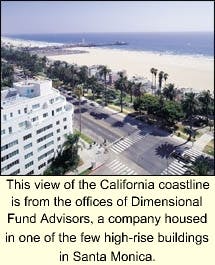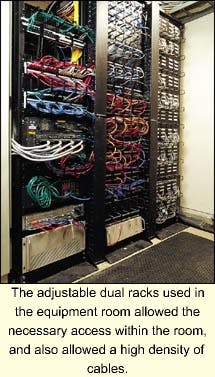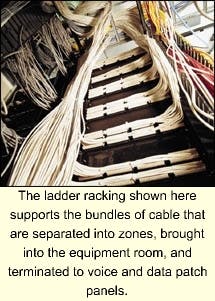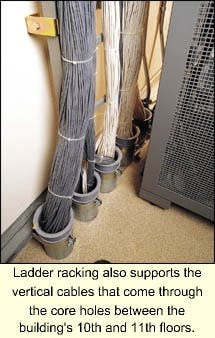A mutual-fund company on the California coast maintains uptime while cabling its workspace.
William N. Farhood, Jr. / BF Datacom Inc.
The headquarters of Dimensional Fund Advisors Inc. (DFA-Santa Monica, CA), a large institutional mutual-fund company, rests on the California coastline, with unobstructed views of the Pacific Ocean, including all of Santa Monica Bay. From the company's 10th and 11th-story offices, the ocean views include all beaches south to Palos Verdes and north beyond Malibu. The offices occupy space in one of the few high-rise buildings in Santa Monica.
The company's recent office expansion and remodel included a complete replacement of the existing voice and data cabling plant. DFA has dozens of high-speed wide-area-network (WAN) links to every major financial news and monitoring service, which lets the company trade and track the full range of financial instruments-from domestic and international markets-in real-time, 24 hours a day. Transactions totaling hundreds of millions of dollars take place instantly during market hours.
Trading activities from several domestic and international offices consolidate at the Los Angeles headquarters. In that office, huge databases are updated daily, and 100% uptime is essential. Along with mission-critical applications like real-time trading, DFA also maintains an extensive client/server local-area-network (LAN) environment with hundreds of users in Santa Monica. It is not unusual for one trader to have four to six computers and multiple monitors on a single desk.
null
Challenges defined
The original Category 3 cabling installed in the Santa Monica office was preventing DFA from upgrading to a switched 100Base-T Ethernet environment, which the company wanted to do. Over the years, innumerable moves, adds, and changes (MACs) had transformed the patch panels and connecting blocks in the equipment room into a hodge-podge of twisted-pair cables, with several unneeded crossconnects taking up space. The cabling mess intensified at the user side-especially underneath the trading desks, where abandoned cables, and split or so-called "stolen" pairs were used to accommodate the growing array of multiple devices at each desk.
Additional concerns included consolidation points that were serviced by boxes with missing covers. Some looked like a mere touch would cause some kind of network outage. The situation was further complicated by powered telephone headsets and recording devices, shared analog modems, dozens of transformers for various devices, power strips, uninterruptible power supplies, and lengthy phone-station cords-none of which were coordinated or organized in any particular fashion. And the raceways underneath the desks resembled a tasty dish from an Italian restaurant-spaghetti surprise.
BF Datacom (Marina del Rey, CA) was one of the companies DFA contacted to bid on the project, which specified replacing the entire cabling plant. From the time of the initial contact, we had keen interest in the project, primarily because of the ideal location and proximity to our office. We believed we could service the account better than other bidders because we were physically closer to the jobsite, and therefore, more readily available anytime.
The project presented some unique challenges, but also some that many other cabling crews face from time to time. One challenge was that all the work, including complete removal of the old cabling, would have to be carried out without any disruption to normal business. DFA also wanted all its voice cable to terminate at patch panels, not blocks, so that the company could make MACs themselves.
The company specified Category 5E for both voice and data cabling, because this setup allows maximum flexibility at each workstation outlet. Specifications called for six Category 5E cables at each location, as well as complete system certification and documentation.
Planning ahead
Because system cutover would be spread out over several phases, the installation required a significant amount of planning. With this in mind, and to show our company's interest in securing the bid, we visited the site several times in the weeks following our initial contact. With permission from DFA's information-technology (IT) department, we accessed the system's pathways, plenum area, floors, server, and switch room, and even the spaghetti factories at the trading desks. After just a brief look at the work areas, we knew that these areas would have to be addressed after regular work hours.
During the weeks before DFA awarded the contract, some of the company's IT personnel called us occasionally with questions regarding our methodology. During those calls, the IT staff also updated us on changes to the project timeline and construction plan. We were involved in several meetings with the telephone-switch vendor, consultants, general contractor, furniture installers, and DFA personnel. At one of the meetings, the consultant revealed that for DFA to achieve compliance with Americans with Disabilities Act (ADA) requirements, the planned setup for the equipment room had to change drastically. Specifically, the plan as written did not allow adequate clearances between different pieces of equipment in the room.
This revelation eliminated cabinets as an option in the equipment room. Ultimately, DFA opted for open relay racks and extensive horizontal and vertical troughs, primarily because the racks allowed for the type of cable management the company required. The style and brand that DFA chose-adjustable dual racks manufactured by Homaco (Chicago)-allowed for nearly twice the cable density as the cabinets originally under consideration. Overall, the adjustable dual racks made the most of the available real estate in the equipment room, and allowed the required access.
Cables by the bundle
The sheer number of cables that would be home-run to the company's equipment room also ruled out ordinary fastening and strapping products. Because DFA already occupied the 11th floor penthouse, and was taking over the 10th floor as well, the cabling from all 10th-floor workstations would come up through the floor via five new 4-inch core holes in the existing equipment room. In addition, the plan called for the trading desks on the 11th floor to be fed from the 10th floor through 3-inch cores, in an effort to preserve the furniture's aesthetics and provide sufficient access to the trader pods.
Anticipating a stringent inspection from the local building and safety department, we installed cable tray the entire length of the 10th floor, on the same side of the floor as the 11th-floor equipment room. This cable-tray positioning let us place the majority of the cables in the neatest way possible, with bundles coiled underneath the core locations.
After drilling all the necessary 2-, 3-, and 4-inch cores, we assembled the cable tray, shooting 1/4-inch rodding into the deck and hanging the tray from the rods. Maneuvering the tray around ducting required us to keep the turn angles small, and challenged us to keep the tray's height consistent along its entire length. Once we installed the entire tray, we shot more rods into the ceiling and hung LANCat bags from ERICO Inc. (Solon, OH) for smaller cable bundles.
The customer required six Category 5E cables at each workstation-two gray cables for voice outlets and four white cables for data outlets. We decided to pull 36 cables at a time, which meant we would need a 48-port data patch panel for every two pulls, and a 48-port voice patch panel for every four pulls. Although we were pulling 36 cables at a time, we planned to bring those pulled cables into the equipment room 48 at a time, so that we would have exactly enough cables for a 48-port patch panel each time we brought a bundle into the equipment room. So, as we completed each pull, we organized the cables into separate voice and data bundles; then, when a bundle reached 48, we pulled it into the room.
We used a rolling scaffold to quickly move the 36 boxes of cable around the floor with each pull. We carefully dressed and verified the count of each bundle before pulling them into the equipment room, which let us isolate 48-cable bundles one at a time and mark the layout in zones. As the cables began to proliferate, all that up-front work paid off because once we pulled a bundle into the equipment room, we only had to dress the cables into the racks and punch them down to the patch panels. No reorganization or further separation was necessary.
We also foresaw the need for connectivity between the several backboards in the equipment room, which had dozens of data circuits that needed tagging and documentation. We pulled approximately 350 cables just to provide this connectivity between servers, racks, data circuits, and trading services on the floor below.
Before long, the entire 10th floor was pulled, punched, and certified. A fresh print from the architect indicated cable numbers and zones. Paint, carpet, and furniture rapidly followed, and the areas were occupied soon thereafter.
Moving up to the penthouse
The 11th floor contained hard offices, including the executive offices, along the entire periphery. The trading desks were in a large open area in the center of the floor. Several 3-inch overhead conduits already fed four sets of pods. The existing cables, however, were Category 3 and had to be pulled out.
In true cabling-crew fashion, we went to work early one Saturday morning, coring the 11th-floor trading desks and bringing up cables from the 10th floor. We installed the Category 5E jacks during the week, including some that we installed after the close of domestic trading.
We connected both the data and voice drops for traders on the 11th floor after hours, and also pulled the old Category 3 out of the overhead conduits when the office was unoccupied. Because the lengths of conduit are still in fine shape and can be reused at any time, we left a pull rope in each one. In fact, some lengths of 3-inch conduit are now empty, which gives the user an opportunity to add cables in the future. Removing all the old cable required a lot of care, but freed up significant space in the existing cable troughs.
Although we originally expected to have to use crawl spaces near the spots where hard ceilings existed, once renovations of the areas began in earnest, we realized we could use existing pathways, telephone closets, and some existing conduit. The ability to use these already-in-place elements made pulling cable on the 11th floor easier. After we pulled all the 11th-floor cables, we installed jacks at each location according to the general contractor's needs. Essentially, as the general contractor went through the entire floor and renovated the balance of the offices, we installed the jacks at each location. Fortunately, there were few changes to the original plan for this floor, and we only had to open the hidden-spline ceilings one more time for the new trading desks.
Because we could not disturb the traders during regular work hours, we chose to spend some of the regular-business work hours certifying cabling runs to Category 5E with our OMNIScanner. There were also other considerable windows of time during construction when we could not access the work areas. So, we filled this time completing documentation, reconciling spare analog lines and circuits, and completing other tasks for DFA's IT staff.
Because the voice pairs that fed into DFA's switch had to be repeated at the voice and data racks, we installed preterminated BIX blocks, with 50-pin Amphenol connectors, to 1-pair RJ-11 48-port patch panels using 25-pair cable. In all, 900 RJ-11 ports are available, and are clearly labeled. Members of the DFA staff can now facilitate MACs by moving an RJ-11 straight-through patch cable to the desired extension and jack number.
Once we got deep into the project, the costs were significantly under the original bid. So, DFA let us handle their MAC needs for the duration of the project. We were also involved in some aspects of the network installation that went beyond cable pulling, terminating, and testing. For example, a huge air-conditioning unit was put in the equipment room, and 3,000 pounds of batteries were brought into the financial-services intermediate crossconnect on the 10th floor to serve mission-critical electrical needs.
Some after-hours work included relocating equipment and circuits, and dealing with other wrinkles in the buildout plan. But such situations are normal in construction projects: They were all addressed appropriately, and various contractors-we, included-successfully carried out work-around plans.
In all, we installed more than 160,000 ft of plenum-rated Category 5E cable and more than 40 48-port patch panels. The job was a positive experience for our entire crew, and the DFA personnel did their best to accommodate our needs. Fortunately, the spirit of cooperation among all subcontractors on the site let us complete the job for approximately 15% less than the original proposal. And that included installing about 50% more cabling than originally planned.
Lessons learned
In some ways, this project can be considered unique, but in many other ways, it parallels many cabling jobs. And I believe that in these parallels are lessons from which cabling crews and end-user organizations can learn and prepare for their upcoming projects:
- Winning the bid. As I mentioned, I believed my company's close proximity to the jobsite would work in our favor. And perhaps it did, in some ways. Overall, I believe it was our responsiveness to the client's initial needs and requests that went a long way toward winning the bid. Maybe DFA had already made up its mind to hire us when it called to ask about our methodology and update us on the project timeline. But maybe those calls were just another part of the bidding process, to see how each of the bidding companies responded. Obviously, there is not much you can do about how close or far away your office is from a job you are bidding. But to the extent that you can respond to the potential client's needs, do it.
- Expect the unexpected. I don't think anybody foresaw the fact that we could not use cabinets in the equipment room because they would keep the client from achieving ADA compliance. But that's cabling. You have to be prepared for the unexpected, and be willing and able to change plans with as little disruption as possible. I also noted earlier that we ended up installing almost 50% more cabling than we originally planned. Again, that's an unexpected element, but as a cabling installer, you cannot let that keep you from moving ahead with the project.
- Expect the expected. In addition to handling unexpected events, the way a cabling installer deals with typical project situations, including scheduling, is also critical. Our willingness to work outside-sometimes way outside-regular business hours was instrumental in the timely completion of this project. While DFA personnel occupied the space, we carried out non-intrusive tasks, such as system certification and work in the equipment room. We cabled the workstations when the traders were not in the office.
Overall, we are proud of the work we carried out at Dimensional Fund Advisors, and we are confident that the installed cabling plant will let the company take advantage of state-of-the-art connectivity well into the new millennium.
William N. Farhood, Jr., RCDD, is president of BF Datacom Inc. (Marina del Rey, CA).





